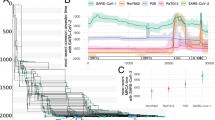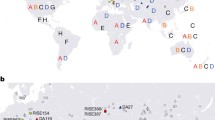Abstract
Accurately estimating the evolutionary rate and age of hepatitis B virus (HBV) has proven to be one of the most difficult problems in studies of viral evolution. To help resolve these issues we employed a recently developed Bayesian coalescent approach to globally sampled human and avian hepadnavirus genome sequences, accounting for lineage-specific rate variation, the presence of overlapping reading frames, and the potential impact of recombination. Our analysis revealed an unexpectedly high rate of evolutionary change—up to 10−4 nucleotide substitutions (subs) per site per year and always more than ~10−6 subs/site/year. These rates suggested a time to the most recent common ancestor (tMRCA) of the sampled isolates of consistently less than ~1500 years ago for human HBV and less than 6000 years ago for the avian hepadnaviruses. Notably, the evolutionary rate of nonoverlapping regions of the viral genome was ~2-fold greater than that of overlapping genome regions, reflecting the complex patterns of selective constraint inherent in the former. We also reveal that most recombination events in both human and avian HBV tend to fall in a specific region of the viral genome, which contains all four viral open reading frames and which may therefore represent a “hot spot” for recombination. However, while recombination affects estimates of both evolutionary rate and tMRCA, in no case was this sufficient to challenge the hypothesis that the dominant mode of HBV evolution is by recent cross-species transmission. We conclude that HBV exhibits rapid evolutionary dynamics, typical of other viruses dependent on reverse transcriptase-mediated replication.



Similar content being viewed by others
References
Bollyky PL, Holmes EC (1999) Reconstructing the complex evolutionary history of hepatitis B virus. J Mol Evol 49:130–141
Bollyky PL, Rambaut A, Harvey PH, Holmes EC (1996) Recombination between sequences of hepatitis B Virus from different genotypes. J Mol Evol 42:97–192
Bowyer SM, Sim JGM (2000) Relationships within and between genotypes of hepatitis B virus at points across the genome: footprints of recombination in certain isolates. J Gen Virol 81:379–392
Cui C, Shi J, Hui L, Xi H, Zhuoma, Quni, Tsedan, Hu G (2002) The dominant hepatitis B virus genotype identified in Tibet is a C/D hybrid. J Gen Virol 83:2773–2777
Drake JW, Charlesworth B, Charlesworth D, Crow JF (1998) Rates of spontaneous mutation. Genetics 148:1667–1686
Drummond AJ, Rambaut A (2003) BEAST v1.0. Available at: http://www.evolve.zoo.ox.ac.uk/beast/
Drummond AJ, Nicholls GK, Rodrigo AG, Solomon W (2002) Estimating mutation parameters, population history and genealogy simultaneously from temporally spaced sequence data. Genetics 161:1307–1320
Drummond AJ, Rambaut A, Shapiro B, Pybus OG (2005) Bayesian coalescent inference of past population dynamics from molecular sequences. Mol Biol Evol 22:1185–1192
Drummond AJ, Ho SYW, Phillips MJ, Rambaut A (2006) Relaxed phylogenetics and dating with confidence. PLoS Biol 88:699–710
Fares MA, Holmes EC (2002) A revised evolutionary history of hepatitis B virus (HBV). J Mol Evol 54:807–814
Hanada K, Suzuki Y, Gojobori T (2004) A large variation in the rates of synonymous substitution for RNA viruses and its relationship to a diversity of viral infection and transmission modes. Mol Biol Evol 21:1074–1080
Hannoun C, Horal P, Lindh M (2000) Long-term mutation rates in the hepatitis B virus genome. J Gen Virol 81:75–83
Jenkins GM, Rambaut A, Pybus OG, Holmes EC (2002) Rates of molecular evolution in RNA viruses: a quantitative phylogenetic analysis. J Mol Evol 54:156–165
Kumar S, Tamura K, Nei M (2004) MEGA3: Integrated software for molecular evolutionary genetics analysis and sequence alignment. Brief Bioinform 5:150–163
Kurbanov F, Tanaka Y, Fujiwara K, Sugauchi F, Mbanya D, Zekeng L, Ndembi N, Ngansop C, Kaptue L, Miura T, Ido E, Hayami M, Ichimura H, Mizokami M (2005) A new subtype (subgenotype) Ac (A3) of hepatitis B virus and recombination between genotypes A and E in Cameroon. J Gen Virol 86:2047–2056
Luo K, Liu Z, He H, Peng J, Liang W, Dai W, Hou J (2004) The putative recombination of hepatitis B virus genotype B with pre-C/C region of genotype C. Virus Genes 29:31–41
Martin DP, Williamson C, Posada D (2005a) RDP2: recombination detection and analysis from sequence alignments. Bioinformatics 21:260–262
Martin DP, van der Walt E, Posada D, Rybicki EP (2005b) The evolutionary value of recombination is constrained by genome modularity. PloS Genet 51:475–479
Mizokami M, Orito E, Ohba K, Ikeo K, Lau JYN, Gojobori T (1997) Constrained evolution with respect to gene overlap of hepatitis B virus. J Mol Evol 44:83–90
Okamoto H, Imai M, Kametani M, Nakamura T, Mayumi M (1987) Genomic heterogeneity of hepatitis B virus in a 54-year-old woman who contracted the infection through materno-fetal transmission. Japan J Exp Med 57:231–236
Olinger CM, Venard V, Njayou M, Oyefolu AO, Maiga I, Kemp AJ, Omilabu SA, le Faou A, Muller CP (2006) Phylogenetic analysis of the precore/core gene of hepatitis B virus genotypes E and A in West Africa: new subtypes, mixed infections and recombinations. J Gen Virol 87:1163–1173
Orito E, Mizokami M, Ina Y, Moriyama EN, Kameshima N, Yamamoto M, Gojobori T (1989) Host-independent evolution and a genetic classification of the hepadnavirus family based on nucleotide sequences. Proc Natl Acad Sci USA 86:7059–7062
Osiowy C, Giles E, Tanaka Y, Mizokami Y, Minuk GY (2006) Molecular evolution of hepatitis B virus over 25 years. J Virol 80:10307–10314
Simmonds P (2001) Reconstructing the origins of human hepatitis viruses. Phil Trans R Soc Lond B 356:1013–1026
Simmonds P, Midgley S (2005) Recombination in the genesis and evolution of hepatitis B virus genotypes. J Virol 79:15467–15476
Suwannakarn K, Tangkijvanich P, Theamboonlers A, Abe K, Poovorawan Y (2005) A novel recombinant of Hepatitis B virus genotypes G and C isolated from a Thai patient with hepatocellular carcinoma. J Gen Virol 86:3027–3330
Swofford D (2003) PAUP*. Phylogenetic analysis using parsimony (*and other methods). Version 4 ed. Sinauer Associates, Sunderland, MA
Starkman S, MacDonald DM, Lewis JCM, Holmes EC, Simmonds P (2003) Geographic and species association of hepatitis B virus genotypes in non-human primates. Virology 314:381–393
Wang Z, Liu Z, Zeng G, Wen S, Qi Y, Ma S, Naoumov NV, Hou J (2005) A new intertype recombinant between genotypes C and D of hepatitis B virus identified in China. J Gen Virol 86:985–990
World Health Organization (2000) Hepatitis B: World Health Organization fact sheet 204. Available at: http://www.who.int/mediacentre/factsheets/fs204/en/
Yang J, Xing K, Deng R, Wang J, Wang X (2006) Identification of Hepatitis B virus putative intergenotype recombinants by using fragment typing. J Gen Virol 87:2203–2215
Acknowledgments
We thank Dr. K. Abe, Dr. R. Chakravarty, Dr. Y. Tanaka, Dr. H. Okamoto, Dr. F. Pujol, Dr, Y. Muraki, Dr. K. Fujiwara, Dr. Y. Wen, Dr. P. Karayiannis, Dr. J. Newbold, Dr. W. Hans, Dr. J. Giambrone, and Dr. M. Kew for kindly providing additional information concerning the sequences they generated.
Author information
Authors and Affiliations
Corresponding author
Electronic Supplementary Material
Rights and permissions
About this article
Cite this article
Zhou, Y., Holmes, E.C. Bayesian Estimates of the Evolutionary Rate and Age of Hepatitis B Virus. J Mol Evol 65, 197–205 (2007). https://doi.org/10.1007/s00239-007-0054-1
Received:
Accepted:
Published:
Issue Date:
DOI: https://doi.org/10.1007/s00239-007-0054-1




